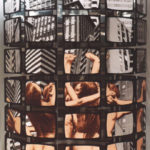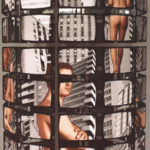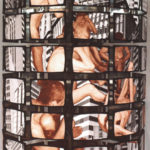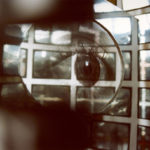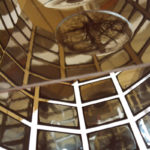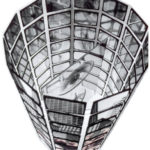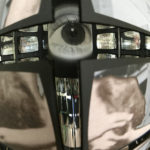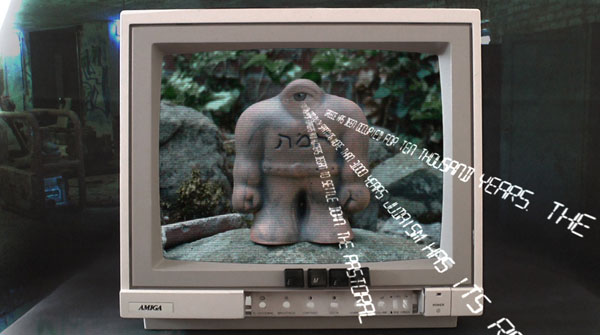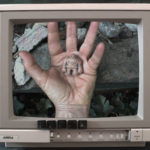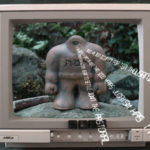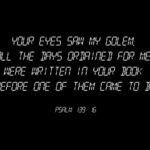NIEUWE VERSIE 2018, met een nieuwe interpretatie van het oog en het hart, in een tentoonstelling in Praag in mei 2018!
meer over de tentoonstelling
titel: Het oog van de Golem
techniek: inkjet- en laserprint op papier en film, spiegelfolie, perspex, tempex, karton
afmetingen: cylindervormige installatie, samengesteld uit 96 panelen en een centraal element, totale afmetingen: diameter 82 cm, hoogte 121 cm / nieuwe versie: diameter 50 cm, hoogte 80/170 cm
jaar: 2000-2001
© Maria Korporal
 De Joodse legende van de Golem, een pop van klei die tot leven kan worden gebracht met behulp van kabbalistische krachten, is vanouds een uitgangspunt geweest voor creatieve geesten, van schrijvers tot filmers, van filosofen tot wetenschappers. Velen hebben de Golem getransformeerd in een symbool van de technologie, anderen beschouwen hem als representant bij uitstek van het moderne denken, in staat zich aan te passen aan verschillende tijden en omstandigheden. In haar essay behandelt de kunstenares een aantal voorbeelden.
De Joodse legende van de Golem, een pop van klei die tot leven kan worden gebracht met behulp van kabbalistische krachten, is vanouds een uitgangspunt geweest voor creatieve geesten, van schrijvers tot filmers, van filosofen tot wetenschappers. Velen hebben de Golem getransformeerd in een symbool van de technologie, anderen beschouwen hem als representant bij uitstek van het moderne denken, in staat zich aan te passen aan verschillende tijden en omstandigheden. In haar essay behandelt de kunstenares een aantal voorbeelden.
Maria Korporal geeft een eigen interpretatie aan de wereld van de Golem in het werk “Het oog van de Golem”. De installatie is cilindervormig en hangt aan het plafond. Aan de buitenkant is een urbanistisch landschap verbeeld, terwijl aan de binnenkant een geheel verschillend tafereel is te zien, samengesteld uit spiegels: de binnenzijde wordt een oneindige ruimte. Het werk heeft dus een buitenkant en een binnenkant, die twee verschillende en tegengestelde werelden verbeelden, maar tegelijkertijd afhankelijk zijn van elkaar.
Interview with Maria Korporal in 2000:
Where did your interest in Golem come from?
M.K .: “My first meeting with the Golem occurred during the reading of Gustav Meyrink’s novel The Golem, at the beginning of 2000. I had already read other books by this author, but this one struck me the most. I did a series of Internet searches on the Golem and I found a lot of interesting things. Then the idea of dedicating a work of art was born. “
In what way do you consider the Golem a symbol of technology, or the representative of modern thought?
M.K .: “I learned the idea of the Golem as a symbol of technology, etc. only when reading articles and books about it. The Golem symbol of technology is a very interesting and thought-out idea, but I personally prefer to imagine the Golem as a symbol of modern imagery. Many of my works (even those made before the Golem) are built in fictitious TV frames. I think that the imagination of mankind in the contemporary world is largely carried out through the screen (television, internet), which then has important effects on our way of seeing and experiencing (distorted) reality. This is the main theme of my artistic research of the last years and the idea of the Golem fit perfectly in it.“
In what sense does your work represent the Golemian universe? Or rather, in what sense does the Golematic Universe find representation in a work that fuses the two universes, internal and external? And what exactly are the two contrasting worlds?
M.K .: “The golemic universe (cylindrical = universal) is divided into two worlds:
– the “external” one, that is the concrete and material reality, the external part of the “cylinder”, naked bodies and their concrete dwellings.
– the “internal” one, that is the imaginary, the “internal space” of the human mind. The inside of the cylinder is composed of wavy mirrors, with two elements introduced: the Eye (see), which is the instrument of creation and the Heart (living), which has the ability to animate it. Both elements are reflected to infinity, but in an increasingly distorted and fragmented way, in this space of irregular mirrors. A living being imagines but, in turn, is also imagined, ad infinitum, with a tendency to cancel itself (because of the increasing distortion).
I must also underline that there is no just and absolute interpretation, the act of making a work of art goes beyond words and I often “discover” new interpretations too, long after I have done the work.“
So, what is the “eye of the Golem” looking at?
M.K .: “The eye of the Golem looks at itself.”
- The Eye of the Golem © Maria Korporal
- The Eye of the Golem © Maria Korporal
- The Eye of the Golem © Maria Korporal
- The Eye of the Golem © Maria Korporal
- The Eye of the Golem © Maria Korporal
- The Eye of the Golem © Maria Korporal
- The Eye of the Golem – new version 2018 © Maria Korporal
- The Eye of the Golem – new version 2018 © Maria Korporal






